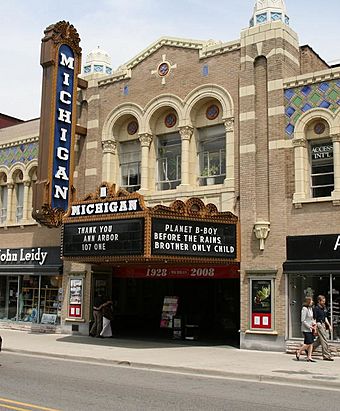Michigan Theater (Ann Arbor, Michigan) facts for kids

Michigan Theater, 2008
|
|
| Address | 603 E. Liberty St., Ann Arbor, Michigan |
|---|---|
| Coordinates | 42°16′47″N 83°44′31″W / 42.27972°N 83.74194°W |
| Operator | Marquee Arts |
| Capacity | 1,610 (Auditorium) 200 (Screening Room) |
| Construction | |
| Opened | January 5, 1928 |
| Architect | Maurice Herman Finkel |
|
Michigan Theater Building
|
|
| Location | 603 E. Liberty St., Ann Arbor, Michigan |
| Area | less than one acre |
| Built | 1927 |
| Architectural style | Late-19th and 20th-century revivals, Lombard Romanesque |
| NRHP reference No. | 80001917 |
| Added to NRHP | November 28, 1980 |
The Michigan Theater is a beautiful old movie theater in Ann Arbor, Michigan. It's close to the University of Michigan. This special place shows independent movies, live plays, and awesome music concerts.
A talented architect named Maurice Herman Finkel designed the theater. It was built in 1927. The main room, called the auditorium, can hold 1,610 people. It still has its original 1927 Barton Theatre Pipe Organ. It also has an orchestra pit, a stage, and many fancy decorations.
The theater was first owned by Angelo Poulos. For many years, it was rented out to a company called W. S. Butterfield Theatres. They also managed the nearby State Theater. Today, both theaters are owned and run by a non-profit group called Marquee Arts.
Contents
History of the Michigan Theater
The Michigan Theater first opened its doors on January 5, 1928. At that time, it was the most amazing theater in Ann Arbor. It wasn't just for movies! It also hosted live shows like vaudeville acts, concerts, and touring plays. Famous performers like Jack Benny, Bing Crosby, Paul Robeson, and Ethel Barrymore all appeared there.
In 1956, the theater was updated. Sadly, many of its original fancy designs were removed during this time. Later, not many people were coming to the theater. It was almost torn down in 1978 when its rental agreement ended. But people in the community and local organ players worked hard to save it. They raised money to fix it up and bring back its original look.
In 1999, a second, smaller movie room was added. It's called the Screening Room. It has great sound and can seat 200 people. It can also show movies digitally.
Today, the Michigan Theater is home to several important events. It hosts the yearly Ann Arbor Film Festival. It's also where the Ann Arbor Symphony and the Ann Arbor Concert Band perform. In 2006, it was named the "Outstanding Historic Theatre" by the League of Historic American Theaters. The theater also has special shows for kids called "Not Just For Kids." Plus, it has a concert series called "The Legends of Rock & Roll."
The Amazing Barton Organ
The Barton theatre pipe organ is a very special part of the Michigan Theater. It was built just for this theater and put in place in November 1927. This was just before the theater opened in January 1928.
Many theater organs were built between the 1910s and 1930s. But the Michigan Barton organ is one of only about 45 that are still in their original homes! It has three keyboards, called manuals. It also has thirteen sets of pipes, which is more than other Barton organs in the area. The organ can make many different sounds, including percussion instruments. It also has a "toy counter" with special sound effects for movies. The organ's fancy console can even move up and down on a special lift!
The Barton organ was not used much in the 1950s. It even got damaged by water in the early 1960s. But it was fixed and started being played regularly in the 1970s. This helped people realize how important the theater was and encouraged them to save it in 1978.
The organ is used all the time now. In 2014, its original air blower broke. It was rebuilt with a stronger motor. Between 2018 and 2020, the whole organ was completely rebuilt and restored. It now works like new! The organ is cared for by experts. Staff organists play it regularly before movies and for silent films. This makes it one of the most heard theater organs in the country.
Outside the Theater
The Michigan Theater Building is a large, two-story building. It includes the Michigan Theater itself. It also has seven stores facing the street and offices upstairs. The outside of the building is made of brown brick. It has decorations made of cement and terra cotta.
The main part of the front of the building has the theater entrance and two stores next to it. This part looks like an old Romanesque style. The other five stores are simpler. In this simpler section, there are two slightly set-back stores. They are on either side of the stairs that go up to the second floor. The name of the building is written on the roofline of each section.
The Romanesque theater entrance has cream-colored terra cotta columns and arches. These fancy details are on the second floor. The ones on the first floor were removed during the 1956 update. Above the second-floor arches, there are decorative parts with green and blue terra cotta. More decorations are inside the arches.
Inside the Theater
The Lobby
The inner lobby still has many of its original details. It has a curved ceiling, Romanesque columns, and arch decorations. There is also wood paneling and beautiful wrought-iron railings on the balcony and staircase.
The Auditorium
The main auditorium can seat 1,610 people. It is used for showing movies and for live events. This large room still has some of its original decorative details.
Images for kids





